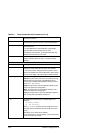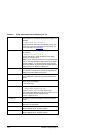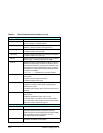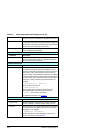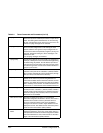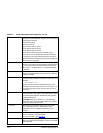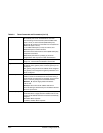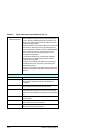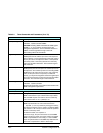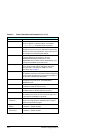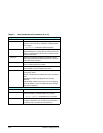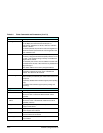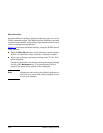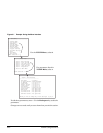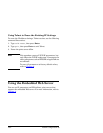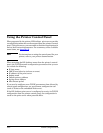
ENWW TCP/IP Configuration 82
SNMP
Command Description
snmp-config Enables or disables SNMP operation on the print server.
0 disables, 1 (default) enables SNMP.
CAUTION: Disabling SNMP will disable all SNMP agents
(SNMP v1, v2, v3) as well as communications with
management applications, such as HP Web Jetadmin. In
addition, firmware upgrades through current HP
downloading utilities will be disabled.
get-cmnty-name Specifies a password that determines which SNMP
GetRequests the HP Jetdirect print server will respond to.
This is optional. If a user-specified get community name is
set, the print server will respond to either a user-specified
community name or the factory-default. The community
name must be ASCII characters. The maximum length is
255 characters.
set-cmnty-name Specifies a password that determines which SNMP
SetRequests (control functions) the HP Jetdirect print server
will respond to. The community name of an incoming SNMP
SetRequest must match the print server’s “set community
name” for the print server to respond. (For additional
security, you may limit configuration access through the print
server’s host access list.) Community names must be ASCII
characters. The maximum length is 255 characters.
default-get-cmnty Enables or disables the default Get community name.
0 disables, 1 (default) enables.
Disabling this parameter may prohibit communications with
SNMP management applications.
SNMP Traps
Command Description
auth-trap Configures the print server to send (on) or not send (off)
SNMP authentication traps. Authentication traps indicate
that an SNMP request was received, but the community
name check failed. 0 is off, 1 (default) is on.
trap-dest Enters a host IP address into the HP Jetdirect print server’s
SNMP trap destination list. The command format is:
trap-dest: ip-address [community name] [port number]
The default community name is ‘public’; the default SNMP
port number is ‘162’. The port number cannot be specified
without a community name.
To delete the table, use ‘trap-dest: 0’.
If the list is empty, the print server does not send SNMP
traps. The list may contain up to three entries. The default
SNMP Trap Destination List is empty. To receive SNMP
traps, the systems listed on the SNMP trap destination list
must have a trap daemon to listen to those traps.
Table 3.4 Telnet Commands and Parameters (10 of 13)



